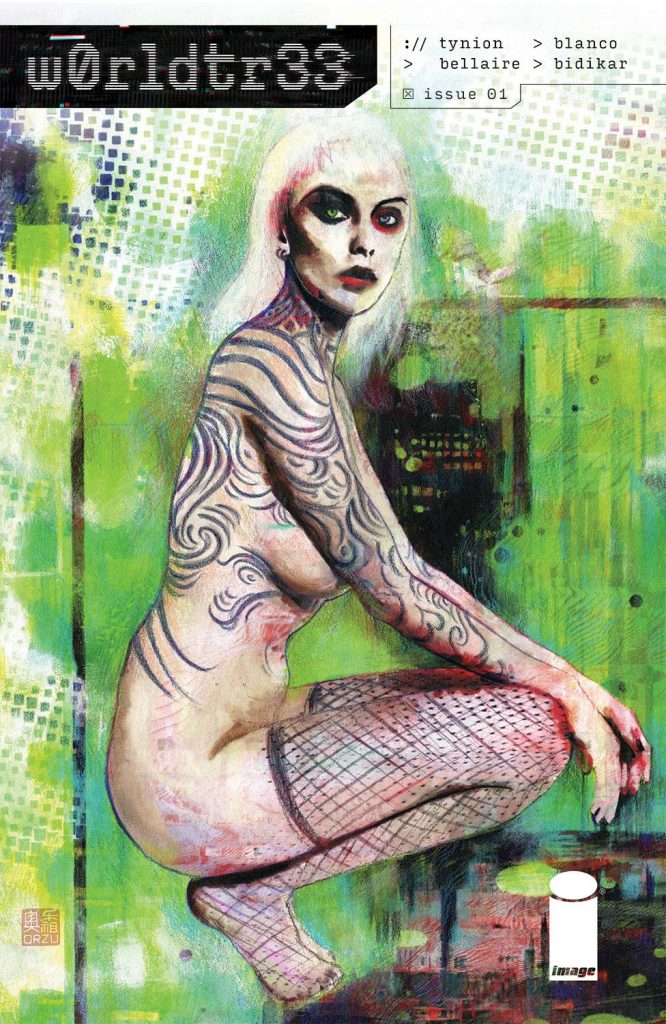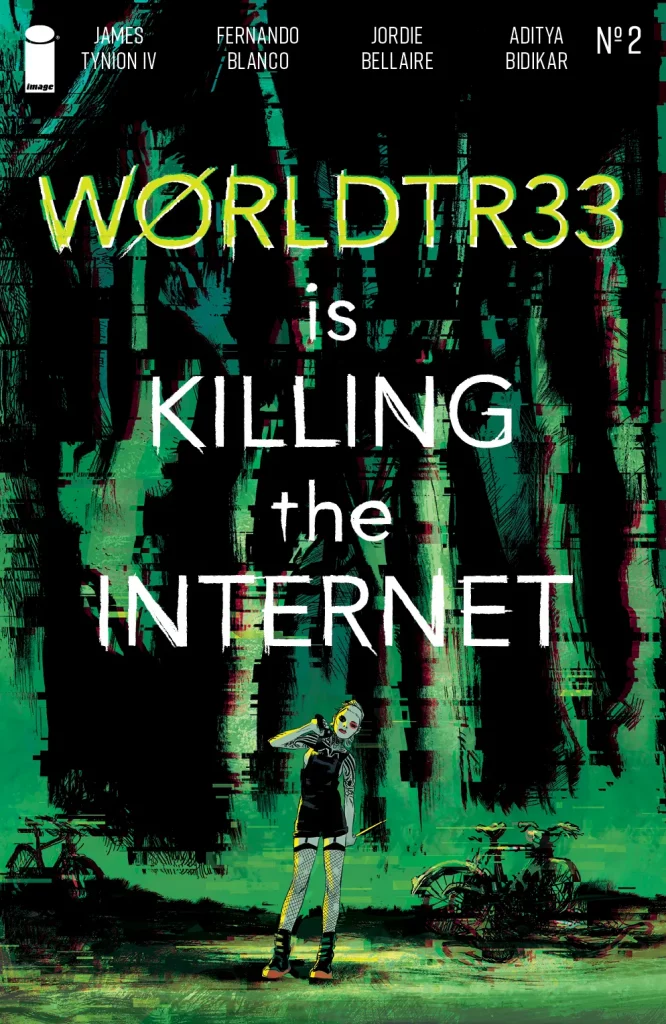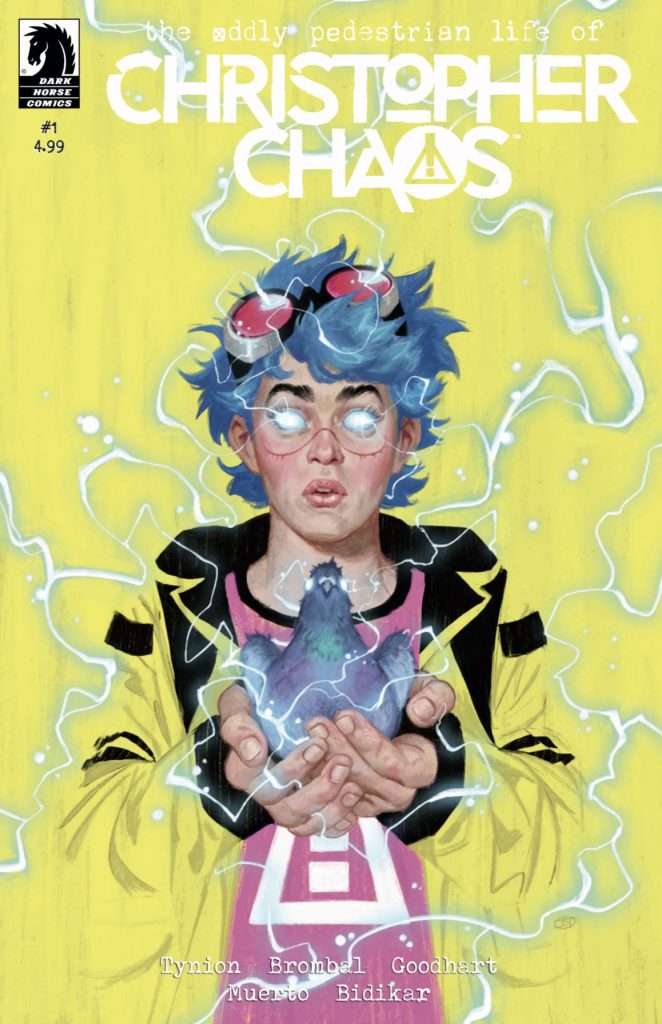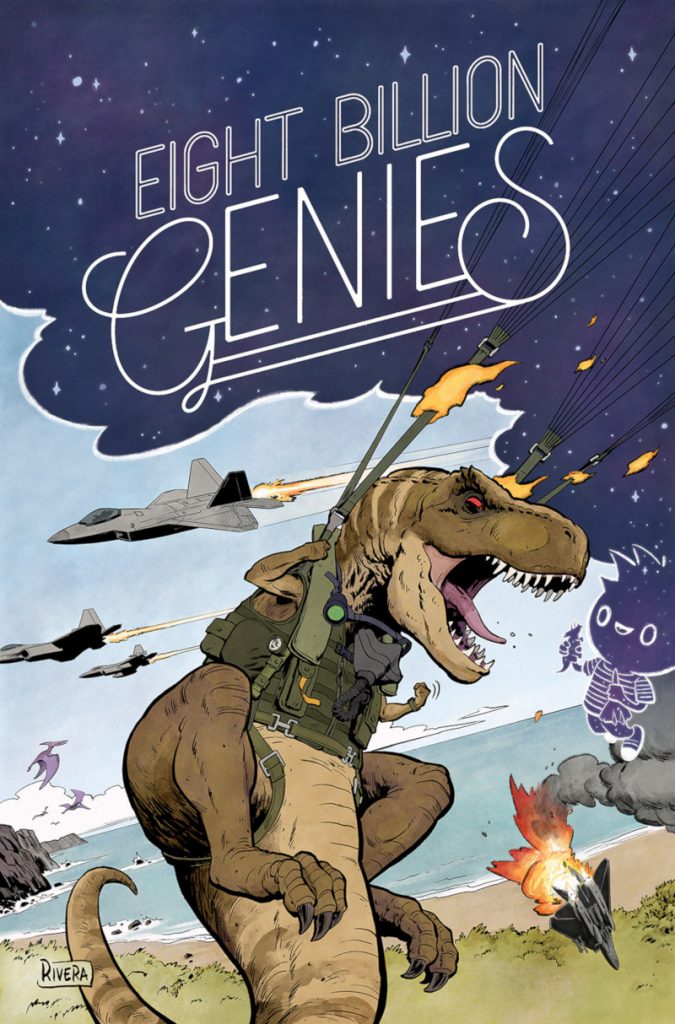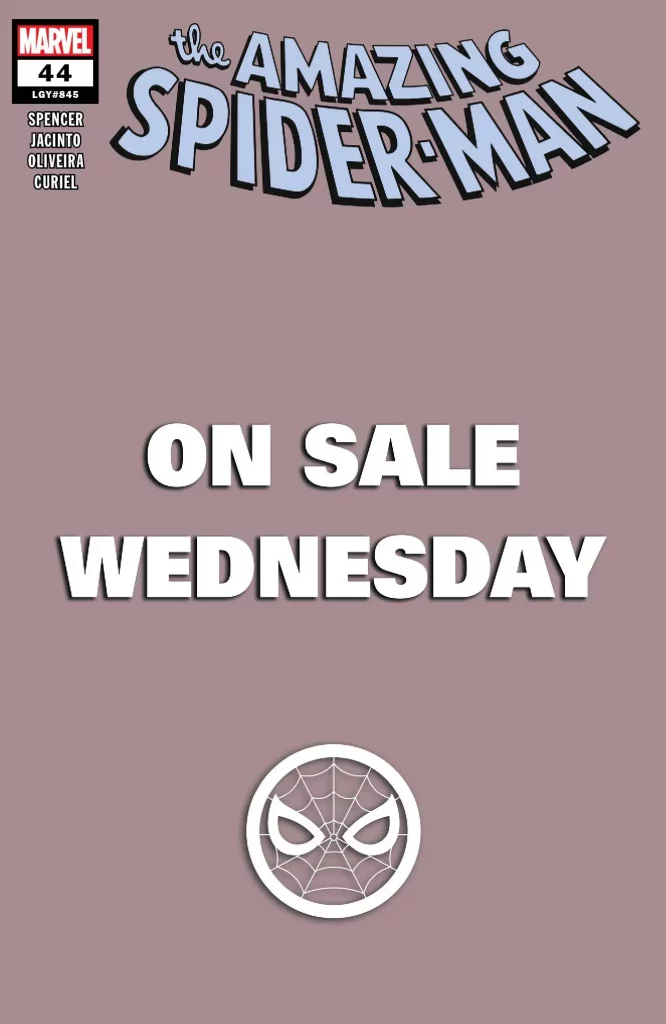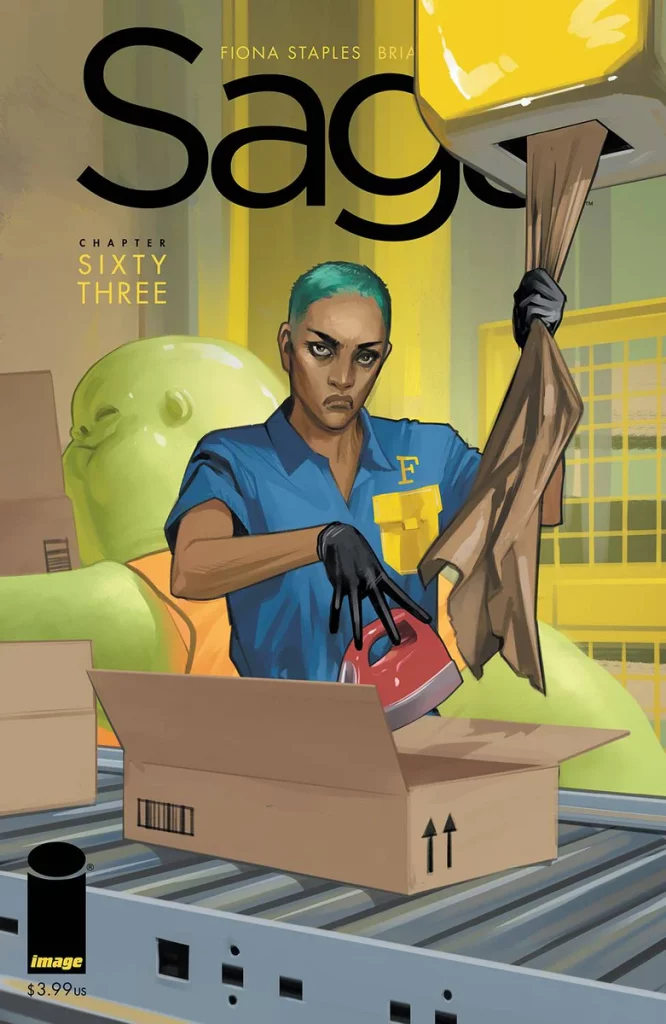SKTCHDxTiny Onion: Part Six, On the Power and Perils of Variant Covers
This one’s been coming for a bit. Variant covers are one of the most polarizing concepts in direct market comics, and writer James Tynion IV is one of the deftest deployers of the concept on his varying creator-owned projects. That’s why when James first pitched me the idea of our SKTCHDxTiny Onion interview series, “variant covers” were I believe the first two words I wrote down for potential subjects. Speaking of…hey, this is the latest entry in that SKTCHD x Tiny Onion interview series, a collaboration between Tynion’s Empire of the Tiny Onion Substack and SKTCHD!

This interview is a doozy, as it’s a two pronged chat on the subject of variants. First, James and I talk about his approach to variants, the thought process behind it, and how it all builds from the core ideas of his projects. It’s a very rational, thoughtful approach. Second, we discuss the unending surge in the use of variant covers industry-wide, and the often…let’s say, less rational and less thoughtful approach behind that. It’s the micro and the macro all in one place, and it’s an honest conversation about the good and the bad of this sales tactic/cover type. I think you’ll dig it.
You can read it below, as it’s open to non-subscribers. If you enjoy the conversation, consider subscribing to SKTCHD for more features like it. Also, this interview has been edited for length and clarity.
So, it’s time to dig into variants. Love them or hate them, they do have an impact, and they are something that you use particularly well. To start with, what is your approach to variant covers? When you’re developing a new project like W0RLDTR33, when do you start putting that side of the project together?
James: I think the key moment in the creative process — when I start thinking about covers and also variant covers — is when I start developing with the artist what I call the key visual of the series. What’s the key image? And it’s something that has always come later in the process, and sometimes I’m wrong about what it is. But it is something where it’s just like, “Okay, what is the singular image?” Whether it’s a character, a monster…oftentimes, it’s a sexy lady, because everyone loves a sexy lady. But also a great monster image, a great costume design. All of these things can come together. But it’s basically, what is a single image that, if you stripped away every other aspect of that cover, there’s no title design, it could be colored or not colored or whatever, you know that it is an advertisement for the book? And it is the book distilled into a single image.
So, you need to know the vibes of the book, you need to know what the central concepts are and all that. I’ve talked about it a bit when it comes to W0rldtr33, where the character of PH34R, she represents a larger element of the series moving forward. And I had that larger element in my head. I did not have her as a singular force in my head, or a singular image.
I forget which convention I was at, but I was sitting at a convention, and I was signing all these books where people had gotten sketch covers featuring the Fictional Woman or the Star-Faced Man from Department of Truth and obviously a million Erica Slaughters, over and over again, and then people getting Punchline sketch covers and all that. And I realized that I still didn’t have that element with W0rldtr33. I’d been having trouble in conversations with Fernando trying to figure out what the first cover was as well.
The first cover of a series, cover A, the main cover, is the most important sales image of an entire series. It is so singularly important, and I am maniacal about getting it right. I’m developing another project right now, and I was telling a very prominent artist, “No, the first idea’s not good enough.” And it’s not that it wasn’t good enough. It’s just it didn’t sell the concept. It was a cool image, but it was only a cool image. It was not a cool image that captured the spirit of the thing, or sold what we were doing uniquely. And it really does come down to, what is that image that just sells the whole book in that singular thing?

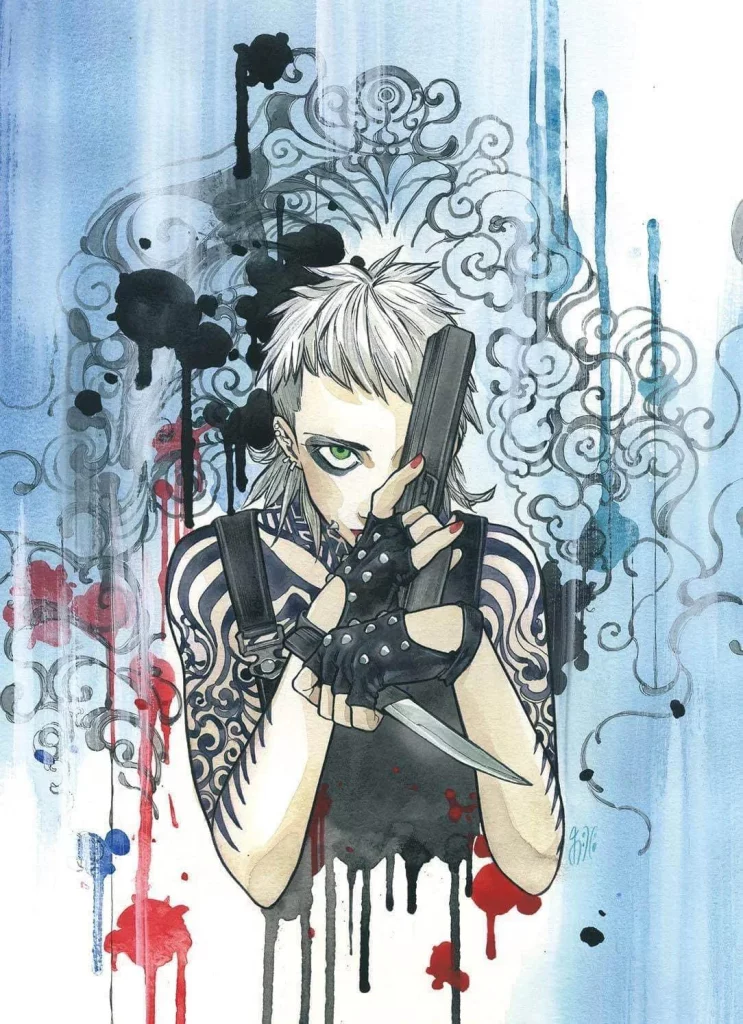
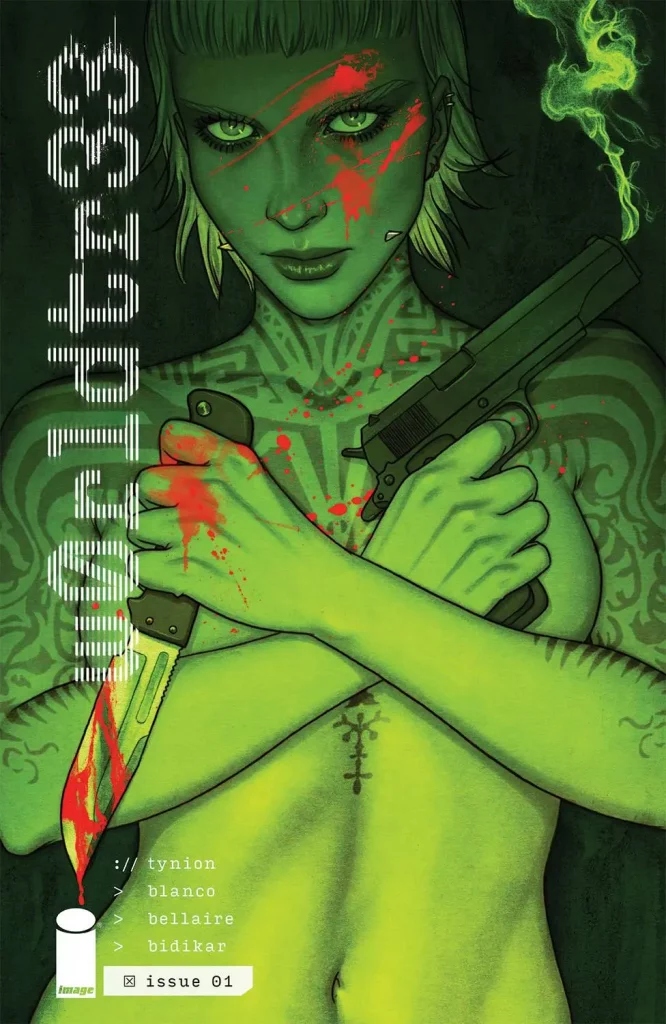
So the variants build off the A cover.
James: Not necessarily. Because The Department of Truth, the cover As very rarely feature the Fictional Woman, the woman with the X’s for eyes. But that initial cover with the JFK and the JFK inverted, it evokes her. But she actually came as a concept after that cover existed.
Amazing.
James: Once we had the X eyes, it was just like, “Oh, I see the element that this series needs,” which is also the thing that I was able to get a Jenny Frison cover of. It’s coming up with the thing that’s cool to draw. You know you’ve hit it when the artist gets really excited about drawing that character and then starts drawing that character more often than the other characters that they’re drawing in the book.
And then you understand that other artists are going to feel the same way when they see it, which is the coolest thing with a lot of my books is a lot of times, these artists are reaching out to us to actually get to play with Erica Slaughter, with the imagery in Department of Truth, and that is such a cool feeling, and that’s what I’m chasing a lot of the time.
It’s funny. In a lot of ways, other artists are like your test audience, because if the idea pops and you start seeing them commissioned a lot, or you start seeing them drawing them a lot or art popping up online, that’s when you know something’s really hit.
James: Yes. And a lot of it goes back to Punchline. The initial design of Punchline went out into the world, and within a month, people were cosplaying her and people were drawing her. And it was just like, “Oh crap, this is much bigger than I even anticipated,” because that was a character built for a functional purpose in a story. People are just like, “Oh, this is when you juiced the sales of the book by introducing a hot new character,” but I had introduced three new characters two issues prior that nobody gave a shit about. I introduce new characters all the time. I’ve always done that. But it was like, “Okay, the Jorge Jimenez design just killed it.” And the concept of her was interesting enough that people wanted to play with her, even though they didn’t know her yet.
And that’s when you see an image of Spider-Man, or an image of Wolverine, that’s what makes you want to read a comic book featuring Spider-Man and Wolverine. We forget how much that these characters are supposed to look cool, and that’s no less true in a creator-owned comic than it is in a superhero book. It’s the same principle. And so it was just like seeing the groundswell around Erica Slaughter, and then Punchline, it was those two together when I was like, “Okay, I need to try to do this deliberately.”
And when I did Department of Truth I realized, “Holy crap, I don’t have that concept in this book.” Everyone’s wearing suits. They’re just generic G-men in suits. And I knew we had the image of the Star-Faced Man that was coming a couple issues in, but we didn’t have the character we could do a Jenny Frison cover for #1. And then I realized the role that that character could play in the whole story, and it just pushes everything in a more comic-booky direction, frankly. That then felt more exciting and interesting to me. It’s not just a sales grab. It’s the thing that makes it feel like a comic book, and there’s so much joy in that.
It is interesting. For everyone who thinks that variants are purely cash grabs, that revenue generating machine, it is interesting to hear how much your “variant program,” if you will, is built off of a very organic need within the story and within the overall architecture of what you’re doing. Going back to the original question I asked, when do you start building out that program? It seems like, not to completely absolve you of it, but to some degree it’s almost out of your control, because you need that singular image before you can start going down that path.
James: Yeah. And then once you have that image, then you can decide how hard you can push into it. Obviously, W0rldtr33, the second that I knew the series was going to have a dangerous assassin lady, that was going to be the central image. And then in talking to Fernando, the idea that she was going to be naked most of the time, it was like, “Okay, we’re going to sell some comic books.” But the goal was to always to make her absolutely terrifying. I think she’s one of the scariest characters I’ve ever written.
But it does come out of the need of the story, and it also comes out of the need of making the story feel right. There’s another character in W0rldtr33 that’s introduced in the second issue, Siobhan Silk, who is going to become a very key character over the course of the series. And she’s just a FBI agent with long red hair and an eye patch, and she just looks like…what I kept pointing to with Fernando is we have to think anime when we’re designing these secondary characters. None of these characters should just look normal people in the world. We’re making a comic book. We are making a science fiction comic book. We have to push everything to the extreme.
And once we got on the same page with that, every new character… In the next issue, you’ll see a glimpse of Siobhan’s boss, who’s basically the czar of all internet crimes within the Department of Justice. And she is a terrifying, terrifying character. And she looks like if Cruella de Vil headlined a 2003 Wildstorm book.
Oh, my God.
James: I love her so much, and she’s showed up on two pages. And it’s so much of the finding the joy in the characters, and finding what’s the way in, what’s the thing that’s just going to be like, “Oh, that’s cool and fun.” I think part of it is I hang out with a lot of artists, so I always notice the things that my artist friends are getting into when it comes to reading their monthly comics. And sometimes they’ll be reading a comic that’s not a good comic, and they just love seeing this one character or this one character’s power set in all these different ways. The story is almost immaterial. That is an entirely secondary concern. And it’s just reminding myself that that’s the artist’s priority, and the artist is the thing that makes it a comic book.
So, it becomes, how can I tap into that? And how can I create enough fun source material that then allows for many characters like that, that then can be put on covers that can be shown in all of these exciting new ways, that help define the tone of a book in and of themselves? All of the different images of Erica Slaughter help define Erica Slaughter in this moment of comic book pop culture. All of the different images of the Fictional Woman do the same. All of the images of PH34R now do the same. The more you see the character iterated, and you see how cool they look in each of those iterations, it sells the central conceit of the comic.
And then on top of that, I like comic book art. I love cool illustrations, and I like seeing a bunch of very talented people draw my characters. I’m at this point where I get the most talented people in the business to draw my original characters, and it is the best feeling in the world.
So, that actually does tie into something I want to bring up, which is the artist themselves. What do you look for when it comes to variant artists? When you’re looking for a variant artist, it seems like a fair amount of it comes down to affinity for their work. But looking at the architecture of W0rldtr33’s initial variants, it seems like part of it is you look at perceived sales heat, somebody who can actually drive sales, but also part of it’s like, “Man, I can get David Aja or Bill Sienkiewicz?” And then you’re like, “I’m going to get David Aja and Bill Sienkiewicz.” Is it balancing out your affinity with the needs of the market?
James: Yes. 100%. And that’s how we’ve stacked the ratio variants. The artists that I went for at the higher ratio variants, like the 1:50s (meaning shops have to order 50 A covers to get one of the variants), and then we did the Peach Momoko at 1:75 for the first issue, those are all artists that I know that the collector market’s very excited about right now. And honestly, so much of that, I started a list while I was at conventions, because I would see…frankly, it was the Something Is Killing the Children covers that a bunch of collectors would just bring up over and over and over again. And it’s just like, “Okay, you’re really into this artist, you’re really into this design.”
A lot of them are digital artists, a lot of them are people who draw beautiful women. You can see a touch of manga influence in a lot of them, and there’s a lot more Asian artists coming into the scene that way. It’s the generation of cover artists that have come up following Artgerm. And they’re extraordinarily talented people who are doing these beautiful single character shots. Those artists are wildly popular among the collector set.
And so, I was going through them and picking my favorites, and then I started reaching out to them to do the higher ratio covers, because I know that the higher ratio covers are really only going to be accessible to people who are playing the collector game, who are trying to get the rare covers and like playing with the rare covers. The people who are just fucking cool artists that I just want their stamp on the book? I put them at the lower ratios, because those are the artists where it’s just like, I want someone who likes David Aja’s work to see a David Aja cover on the shelf, and then make a, “Oh, maybe I’ll give this a shot.” That doesn’t make sense to be a cover that’s priced up a crazy amount. That’s where you’re just trying to get someone to pull a book off the shelf.
We’re doing variants on Blue Book and Christopher Chaos, but those aren’t going to be big collector books. So for those books, it’s much more about who’s going to draw a good image of either the essence of Blue Book, which is basically a black, white, and blue image of a UFO scene, or of the character Christopher Chaos and his supporting cast, which I have a bunch of amazing designs, and so I’m more trying to show off, like for Christopher Chaos #1, how cool the Christopher Chaos design is. I just want people to see that, and I want to sear that image into their head, so it’s just like more and more people are just like, “You know what? I want to check that book out.”
That’s my primary goal there. I’m not trying to sell a gazillion copies, so I’m also not chasing, frankly, the cover artist that cost a gazillion dollars to do. But when it’s just like, “Okay, I have a sexy, naked murder lady over in W0rldtr33 that I can get someone who’s going to cost a lot of money to do a higher ratio cover that I know the collector market’s going to go for, because they go for my books, and there’s a character that is going to speak to that audience.”
Are you a Seinfeld person?
James: I’ve seen most of Seinfeld.
Have you seen the episode where they talk about good naked versus bad naked?
James: Oh God, remind me.
Jerry’s dating someone who is always naked, and he’s like, “It’s amazing. She’s so beautiful, blah, blah, blah.” But then he realizes there’s a bad version of naked. There’s this scene where she’s trying to open a jar of pickles while she’s naked, and all the muscles are straining… that’s bad naked. PH34R is fully in the camp of bad naked to me, because as soon as you start murdering a lot of people, you’re just permanently bad naked to me. So, I am apparently not in the sexy lady camp. I’m more like, “She’s a murder lady, so she’s not a sexy lady.”
You’re talking about all the ratio variants versus how you stack those, and how you decide what goes into that. It seems you’re very strategic about this. You have to be smart about how you lay it out, because different artists are going to be a different level of draw. But one thing that I think is an interesting fit in there is you have these homage covers for the first two issues. The Alvaro Martinez Bueno one is a Nice House on the Lake #1 homage for W0rldtr33 #1. Or Werther Dell’edera did a Something Is Killing the Children #1 variant for W0rldtr33 #2. Those are…at least the Werther one is, a 1:100.
James: Yeah.
What’s the purpose of those covers? Is that all about trying to draw in fans of those books, or is it something else?
James: It’s a special gift to the people who have been collecting all of my books at an extreme level for a long time. So basically, there’s a huge collector base around my books that I’m incredibly grateful for that started around Something Is Killing the Children. And there’s a bunch of these Facebook groups and all of that that pay very close attention to my work. And what I wanted to do was create a tier of covers that would be genuinely rare, and make those covers something that that would be a gift. Not a gift, but it’s something that would appeal to that core group.
Because it’s a 1:100. If a store does a retailer variant, they have to do a print run of 500, typically, which means they can then order five of the 1:100 covers. So the stores that have invested the most into this book then get the rarest cover that exists. And then I have made sure that no retailer can do a virgin variant of one of them, or a color variant and all of that. Each of those 1:100s are going to stay pure 1:100s. Those will be the only time they do that imagery.
I’ve pulled this card a few times, homaging myself, and I think this is the last time that I’m going to do it on this level. And I think the artists of all of these books agree. We’ve played this card a few times. So now, this is our last rodeo doing the self-homage, and we’re just having fun with it. But the second that a Nice House fan sees the Nice House W0rldtr33 variant, it’s just like, “Oh, I should check out W0rldtr33.” Just seeing the image floating around online, it creates some buzz, but it’s not a cover they’re just going to see sitting on the shelf, typically, because there are only a few hundred of them in circulation. I think there’s 300 of them in circulation, or something like that.
You just touched on something that I think is important about variants, in that their value is not strictly oriented on sales, in the sense that…Well, they’re not strictly oriented on sales to stores. They are also advertisements for the book before the book ever even comes out. So if you see a kickass Jenny Frison variant or something, and you’re like, “I love Jenny Frison,” you’re going to buy the book. But you also see Jenny Frison share the cover on social, then all of a sudden, her fans are aware of W0rldtr33. That helps. I don’t want to say it’s free advertising, but it’s a nice bonus to the whole thing.
James: I definitely would not call it free advertising.
No.
James: As one who pays for these covers, it is not free advertising. (laughs)
I’m going to say secondary advertising. It’s a secondary benefit.
But that’s the thing. I’ve heard artists describe covers as business cards for them. It’s also a business card for the book, because you have all these covers, and all of a sudden you’re getting the organic spread of social media. All of a sudden, you have people discovering the book because “I love Peach Momoko” or “I love Bill Sienkiewicz.” That is a not inconsiderable additional value beyond the gated sales and all those things.
James: Yeah, 100%. Christopher Chaos is a perfect example of me targeting that element much more than I’m targeting the collector element. I’m going after prominent, queer artists who I know have good followings and I’m friendly with and will support the book. And I want them drawing this cool new character, so that their audiences – who I know like stories that feature queer characters – are going to find out that our book exists and will be interested in checking it out. That’s why we have a line of Phil Jimenez covers over the first five issues, where he’s drawing each of the central characters of the series. That’s why we have the David Talaski cover on #2, because Talaski’s one of the best artists coming out of it, and it’s, frankly, why Nick Robles was brought in to do character designs and covers for the whole series to begin with.
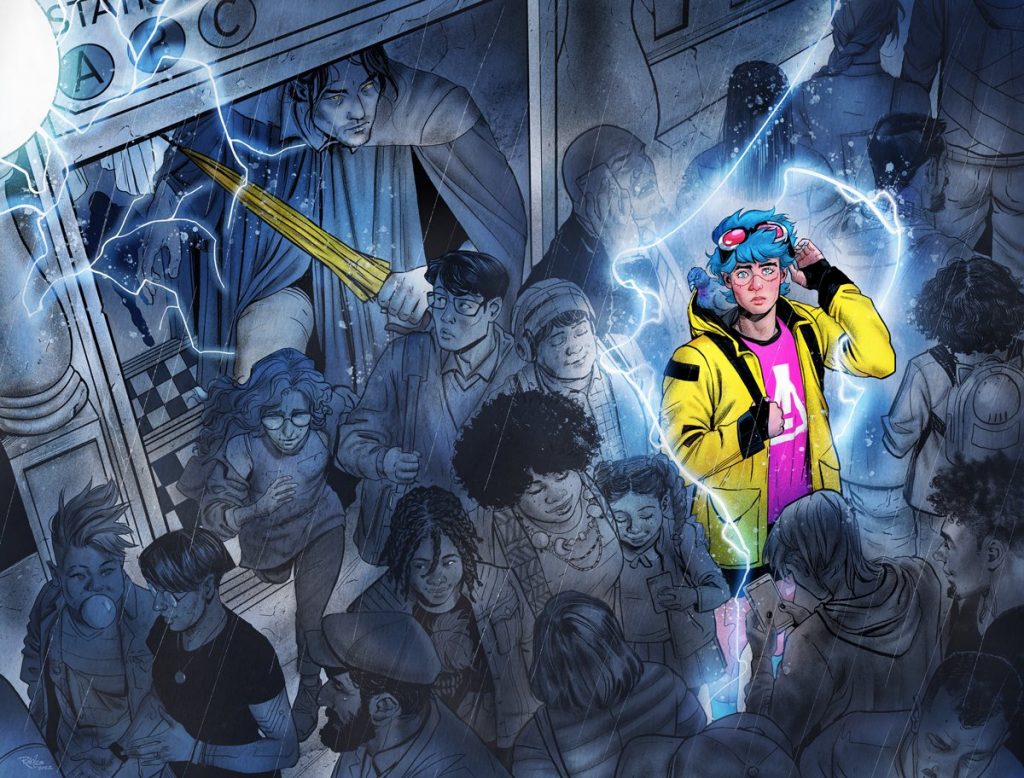
That A cover is amazing.
James: These are exceptionally talented people with big followings, specifically in the queer comic space, and I do want to tap into that audience. That’s the audience. I’m always conscious of who I’m trying to sell to and what I’m selling. That shapes all of my decision making. Especially considering that is me spending my money. I’m not spending DC Comics’ money.
You’ve got to be smart about it.
James: Yeah, I have to be smart, because it’s I can’t spend infinite money on all of these covers unless I know they are going to make the money back. Or at least that they’re going to help create images that then create a groundswell of interest and attention towards a title. That is phenomenally important.
One thing I’m interested in is you have The Onion Club, where you sell fans variants of your comics that you put together yourself. I’m curious as to whether or not that experience offered you any insight into what variant fans are looking for. Did you learn anything useful in that experience? Because you typically have an intermediary between you and variant sales in the form of retailers. This is you selling to fans direct. Did you learn things from that?
James: Sure. I think the primary thing that I learned is that I don’t want to do my own customer service emails. (laughs)
Very reasonable.
James: That is not something I have time to do and is a huge part of the reason that I’ve moved the whole system over to Third Eye (Comics, a retailer in the Maryland/Virginia area). I learn from everything, but this is fascinating. It’s fascinating to so directly communicate with this audience. But I’m not sure that I learned more from that than I’ve learned from just going to shows that have a huge collector presence. I’m going to be doing fewer conventions moving forward, just because I can’t do 10 conventions a year like I used to. I just can’t, emotionally or physically.
But every year I’m going to try to hit one of the big collector shows in the US, because I have a big audience there and I have genuine fans there. And it’s people who started by just collecting Something Is Killing the Children covers. But my favorite in that crowd are the people who got in that way but now read every single issue. And that is not a small number of people. That is a lot of people. Maybe they only started reading it so they could start figuring out, if they’re going to commission a cover, what would they put on the cover that matches the material? But then they get hooked into it, and then they’re always surprised that they got hooked into it.
And one of my favorite things over the last few years is one of their favorite books is The Closet, which I think is it’s because The Closet is about a guy in young middle age, who has a young child, who’s dealing with the sort of day-to-day stuff that I think a lot of people who are in the target age range of the collector market are dealing with. And I had a bunch of people coming up to me, they were trying to explain the concept to me of seeing themselves in a comic, because it’s not something that they’ve experienced very often, at least not that directly. And it was just the most rewarding thing, that this is a group of people that started because they were trying to flip covers but then just got pulled in. I take a lot of pride of catching them in the quicksand.
I personally see myself more in PH34R, because I too am naked all the time and terminally online, so…
James: That’s fair. That’s important. (laughs)
We’ve talked about this in previous interviews to some degree, but I am interested in how your approach to variants has shifted in recent years. Because you’ve said in a previous interview that the collector market is acting and behaving a little differently than it had in recent years when we were in a high time. How has that led to a shift in your own approach?
James: It means that I have to be a lot more judicious. I put out a tremendous number of comics a year, and I have to look at a calendar and make sure that they’re spaced out enough. This year, I have a bunch of #1s, and I tried to make sure that none of them were in consecutive months, that they were all staggered two months away from each other. And I mostly succeeded at that. Not entirely. But for my big, new launches, I managed to succeed with that.
But I knew that the collector market was going to rally behind one of these books. And two years ago, they would’ve rallied behind all of them, because I think there was just a lot more cash flowing through this market. So now they’re more judicious. And I think I said before that it used to be that the collector market kind of chose one book every month to be their key new creator-owned title that they were going to all rally behind. Now, it’s sort of once a quarter, and it’s one of those things where I think an announcement about something moving in Hollywood and these things can happen after the fact. Something can build.
Take Eight Billion Genies. Eight Billion Genies became a huge collector book after the big Hollywood announcement about it. And that is a better example of, I think, what we’re going to see moving forward, is something that retailers might not have ordered tremendously that then has a big second life, which is, frankly, a healthier way that the collector market should build. It’s actually building around collectability, not around pure possibility.
But the reason the collectors circle around my books is because of Something Is Killing the Children. The first print run of the first issue, there’s only, I’m going to get the number wrong, but let’s say there’s 20,000 copies of the cover A in the first printing of Something Is Killing the Children #1 out in circulation. And the second the book started selling out, and going into its eighth printing and things like that, and then the second it started moving in Hollywood and all of that, there was a brief moment where that first printing was going for a thousand dollars. And so it’s just the second that has happened once, then they’re going to pay closer attention.
But they’re also going to gravitate more towards the books that they’re going to gravitate towards. Like The Closet, even though it has a lot of love in the collector space, was not a big collector book and wasn’t a giant seller. It was a three-issue horror miniseries. I never expected it to be. Similarly, Blue Book is a nonfiction UFO comic. That’s not going to appreciate in value in the same way. But W0rldtr33 is a book that’s going to be an ongoing, and it’s something that, like so many of my projects, has a lot of potential in other media. It has an exciting, cool character that the collector market just wants to see in different iterations, and they want their favorite cover artist to draw the character. So it had all of the right elements. So I knew that was the book that I could lean into the most.
And it’s not a mistake that that’s the Image title. That’s the one I invested the most of my own money into, and that’s the one that I put at the company that I knew that I would earn back the most from.
The ceiling is way higher there.
James: Yeah. Versus my Dark Horse books, which frankly, I think they’re going to do very well in the direct market. But I think Blue Book will do really well in libraries because it’s a comic for people who are fascinated about UFOs. They don’t have to know who James Tynion is right, or who Mike Oeming is. That is neutral to the process. My goal with that one is for 10 years from now, that people are like, “Oh, wow, did you know that Blue Book is by the same person who did Something Is Killing the Children?” That’s what I want. It’s me trying to hit an entirely different lane.
It’s interesting how scarcity fits in all of this, because whether you’re talking about Something Is Killing the Children…I don’t want to say it was under-ordered, but its first print certainly was in hindsight. And even Eight Billion Genies proved to be as well. But then on top of that, the ratio variants are fundamentally built on scarcity. If it’s 1:100, that means there are going to be fewer out there. It is interesting to think about that through the prism of the current shape of the variant market, in the sense that in 2022, there were roughly 3.5 variant covers released per published comic, which is a lot.
James: Yeah.
Do you think there’s a version of this where there are just too many variants? And if so, do you think we’re there?
James: I do think that there is such a thing as too many variant covers. I think that a lot of variant covers have been put into the market just because there were people buying variant covers, and then without much consideration put into what the actual value of the comic was. And the idea that if a variant cover exists does not mean that the variant cover is valuable. That’s something I think a lot of people struggle with. And then it’s something that I’m always very cautious about, because I never want someone to pick up a variant cover for one of my books and feel like they’ve been bamboozled.
I know my work has the ability to appreciate in some small way, and I think that the cornerstone of the current collector market isn’t the same as the ’90s version of it. In the ’90s version, it was just kind of mass collecting these #1s under the hope that one of them would be worth a million dollars because Superman or Spider-Man’s first appearance had sold for that. And so it was the idea that these #1s or these first appearances would be worth a million dollars. Now, it’s a small stakes betting thing, where it’s just spending $5 on a cover for the hope that it’s worth $25 a year from now. And at scale, yes, some people can make something very lucrative out of that.
But it’s a hobby, and it’s getting to know the people participating in this. A lot of times, this is what a group of friends does over the weekend. They’ll go and find the hot book of the week and they’ll see whether they can flip it in time. It’s a social, community-driven element of this industry. And it’s one of those things that, at a moment where our industry has so few community-driven elements, when people start talking about, “Oh, we need to strip this out entirely.” It’s like, please don’t. Please don’t strip away the group of people who literally wake up in the morning and put comic books in spreadsheets because they’re thinking about them so much. Please do not chase that group off. Don’t forget, this is a weird nerd hobby, and weird nerds love listing things. I love listing and categorizing things, and this is about figuring out a way to do it.
But there have been people who have leaned way too far into it, where it can feel like the cash grab. And on the titles that I put out, especially the ones where I have the full control over how they’re put into the world, which isn’t every book that I work on, but it’s just the ones where I have the purse strings…I’m choosing what covers we’re doing. That’s why, on my Image books, I never really push past the 1:100.
Beyond that, it feels like fake value. The idea that if you buy 500 copies, you do a retailer variant, you have a limited cover yourself, and then you get five copies of an extra rare thing, that then you can sell for a hundred dollars each? That feels safe and sane to me. But once it starts getting up there…it’s like, okay, this is all approximate value, and it feels like you’re chasing bad habits, you’re not just participating in a market and a community. So, that’s the balance that I’m always trying to strike. And I definitely think that there were companies out there that saw that there was just a lot of money changing hands and just wanted to get the most of it possible.
And, frankly, I don’t understand when the Big Two pushes hard into variant covers? The value doesn’t add up to me. Unless it’s a new character or it’s a key moment, that’s a moment that could be replicated in a film, television, or video game. Unless it’s a new figure being introduced, a new costume…there are things that you can lean into, but sometimes it’s a key issue, and it’s a way to juice the sales. And to that extent, okay, yes, they get more cool artists to draw these characters and all of that. And it’s cool to see a cool artist draw a character you love. But beyond that, what’s the value? What is the actual value of a middle issue of a run that has a high ratio variant? What will the value of that be five, 10 years down the line?
I think that’s where the difficulty lies with the variant question. I’m not a variant buyer. I think you know this.
James: Yeah.
Sometimes it’s less about the number of variants, and it’s more about the lack of thought behind it. Marvel did this one variant program where they literally just had, “On Sale Wednesday” on each cover with a solid color background. It was one of the dumbest things I’ve ever seen in my entire life. It was just to rip DC for going with Lunar and moving the release date to Tuesday.
And I cannot imagine a single person intentionally tried to buy that. Or, if a person did get that, it was the only thing that was available, and I can’t imagine that person was happy about it. It was a non-cover cover. And where this really becomes a problem is when the number and the lack of thought behind it creates a situation where it almost feels punitive to the collectors and it starts driving burnout. That is where the problem starts.
James: And that’s obviously what happened. I think six or nine months ago now, I think everyone was much more worried that we were entering a serious recession than I think people are now. I’m not saying the worry’s gone entirely.
You’re talking about economically, not within comics.
James: Economically, yeah. But because of that, people’s purse strings tightened for the first time in a while, and you could see that happen across the board. This came after a a time when people had been a bit looser about chasing variants, that they thought would have value and all, they were more willing to throw money at a thing without thinking as much about it. And there were companies that leaned very hard into that at the peak of when the money was flowing the most.
I do think that once somebody buys a bunch of stuff, that none of it increases in any value, and they haven’t been able to flip any of it, then they can’t justify continuing that hobby. At that point, if they enjoy reading the books, then that’s why they’ll stick with it. Or, because they enjoy the little communities they’re in, they’ll pick one or two books a year that they participate in, just to stay a part of the Facebook group that they enjoy chatting in every day. But otherwise than that, they just pull back entirely.
And I think because that market was milked for everything that it would give it, we did see a lot of burnout, and I think a lot of people who did burn out aren’t going to come back. But the industry goes through these cycles, and it has always gone through these cycles, where you can kind of parse it out based on the stage someone is in life. Someone probably starts reading as a kid or a teenager, and they’re spending their allowance money on a few comics here and there, or they’re reading their friends’ comics or their parents’ comics. Then they fall out for a few years, usually around college. And then the people who come back in, come back once they have disposable income in their mid-twenties, and they start picking up a few things. And then as their life stabilizes, they pick up more and more and more.
And then they have kids. And once they have kids, they stop reading for five to 10 years, and then they come back in once the kids are old enough and they have a bit more free time, and hopefully they’re doing well in life and have disposable income again. And then it’s like, “Okay, I’m going to spend this disposable income, and I’m going to reconnect with my comic book hobby, because this is me reconnecting with my youth and my younger years.” But then they stay in that for five years or so.
Normally, the market’s kind of moved to a different point. Comics aren’t aimed directly at the 45-year-old reader in the way that they were at the 25-year-old reader. So then there’s eventually a drift off except for the diehards. And so we’ve just had a generation of collectors, and it makes sense because they were the ones who were kids during the collector boom of the ’90s. So they’re tapping into a bit of youthful connection to that. But we’re at the end of that cycle.
So, moving forward, I’m not going to chase the variant market as hard as I have been. I’ll pick one every now and then that I will try to chase hard, because I don’t know that the market supports more than that. But if the market tells me it does, and all of a sudden Christopher Chaos flies off the shelf, and I’m wildly wrong about how I laid out the variant covers there, you can bet your ass I’m going to lean in. But I can’t guarantee that, and I can’t rely on that.
And you don’t want to make the wrong bet either.
James: Yeah.
It’s interesting to think about all of this through the prism of the fact that the highest selling creator-owned series of the past decade or so, Saga, does not use variants at all.
James: Yeah.
It’s not proof that it’s not necessary. I’m not sure what can be taken away from it, besides that Brian and Fiona are really good at what they do, and that Saga is a comic that connected with people. But it is interesting to think about, probably the three single-issue comics that have sold the most in the past decade have been that, Something Is Killing the Children, and The Walking Dead, and they each had wildly different approaches to it. So it definitely shows that there’s no one answer to this.
I guess what we’re getting at though is that where it becomes dangerous is if you just sprinkle variants on your comic and just say, “This is going to deliver sales!” Because it’s not going to all the time. I think that your approach is smart. You don’t just have variants to have variants. You’re having variants because it supports the book in a very specific way, and because it’s thought out very strategically in ways that, frankly, a lot of them aren’t.
James: I appreciate that. Something I learned early on, which was disheartening at first, but then empowering…sometimes you just want other people to be able to make these decisions. But you have to make these decisions deliberately, and you have to make them yourself based on the project and who you’re selling to. So, it frustrates some of my creator friends when they start trying to ask me advice about variant covers, and I just start asking them a bunch of questions about who they’re trying to sell the book to. And that doesn’t feel like a connected call and response, but of course it is.
In those conversations, there are things that I bump into that frustrate me. A lot of times, it’s like people want to tap into the variant market without understanding what brings joy to the collector market and the whole variant scene. You can’t make the collector community care about artists that they haven’t found and discovered, or that they like on their own. You can’t just choose that someone is worth a high ratio variant, just because you like that image the most. They need to be the ones who have made the decision that someone has value.
And you have to have a key image. That’s the thing, I think I put it in a newsletter two or three years ago, but it’s the line that I go back to over and over, is that a bunch of people try to make Transmetropolitan without a Spider Jerusalem. Without that singular image. I think sci-fi can be the worst offender in this arena, where every element is so over the top, there’s no singular element that just sells the entire concept. Which when put on a shelf with a bunch of other science fiction or even horror, it can look generic, without a singular thing that defines what the book is.
So, first, it’s what is the key image? Second, it’s who are you selling it to? Third, you can’t just decide that the audience you want to sell the thing to is going to respond to what you think should go in one of those slots. You do have to interact, and then you have to make a deliberate decision to try to sell to that group.
That is fundamentals of sales right there, to be honest.
James: Yeah.
Know your market, figure out what that market wants, and then deliver that thing to said market. I actually think Eight Billion Genies was uniquely good at that too. That’s part of the reason why that book was successful beyond the Amazon deal. Both the combination of the genies themselves being a great looking image, and then on top of that, the mere concept of wish fulfillment was a great jump off for covers. Their last issue had a Paolo Rivera cover that homaged Calvin & Hobbes. That’s one that was on my list to buy. I forgot about it though because I’m bad at comics.
My last question for you is a tough one, and one we’ve touched on before to some degree. Initial issue sales are crucial to the success of a project, obviously.
James: Yes.
You want to start big, because it’s difficult to go from big to bigger, or even small to big. It’s difficult to grow in this market. The lasting survival of a title largely comes down to continued sales though. When it comes to variants, how do you balance success for today versus success for tomorrow? That’s one of the core questions, and one that a lot of people are failing at. Not necessarily you, but a lot of people.
James: I think all these pieces are connected. Where variants fail, retailers and publishers and the market in general, is if a book, regardless of how good it is, suddenly has this glut of variant covers that are clogging up the shelves that aren’t selling…that is a sign to everyone who walks into a store not to buy the book. It needs to be present. It needs to be something where it’s just like they see it often enough, and they understand that it’s just like, “Oh, that’s moving.” But if they see the same copy of #1 in the same corner of the same shelf that just has not moved in four months, why are you going to pick that book up?
A lot of times when I’m trying to see what are the most successful books when I walk through a comic shop, I ask myself, what are the books that only have a few copies left? But it’s clear that it had a larger footprint that then was shrunk down, rather than the ones that are just like, “Oh, there’s a lot of copies of that just sitting right there that are not moving.
I remember BOOM!’s (President of Publishing & Marketing) Filip Sablik once told me that he thinks speculators actually can drive readers to books, because in a market where there’s more comics than ever, it helps when you have something that points to something as, “This is attractive.” The fear of missing out to it.
James: Yes. 100% And I think that there is something where if you see that lots of people are buying a thing, it makes you want to check it out. That’s just human. If you find out that a movie that you weren’t so sure about is still number one at the box office three weeks in, it’s just like, “Oh, maybe I should see that.” And then if you hear more people are going to see it, then it’s just like, “Ah, you know what? I should actually…” Maybe you didn’t love the first Avatar, but people are saying that they really like this one too, and it becomes, “I might as well go check it out.” And I had a very good time at Avatar 2.
But that’s just part of human nature. Success begets success. And success in the collector market begets success in the reader market, because if the collector market is making a shop order a bunch of copies, it means there’s a bunch of copies flowing through the shop. A lot of shops now do the, “What are the top-selling books?” They’ll show them off in a certain way. And that drives more copies of the book.
And then the other thing that happens, especially when you’re doing a long-form series…this is the trick of long-form series, and it’s why I love long-form series. Volume One of Something Is Killing the Children keeps selling every time a new volume of Something Is Killing the Children comes out. The core audience of the single issues is probably more collector driven, but now there’s a huge reader driven component too. So, we’re selling the book to two audiences at the exact same time. And I do think that part of the magic of Something Is Killing the Children and our sales power is the fact that we’ve managed to hit both. And not all of my titles have hit both.
Something both retailers and publishers have told me is a book almost never…I’m going to say almost never, because I don’t want to say never, because it’s probably happened once or twice…but a book will almost never find an audience in trades if it didn’t have some level of success in single issues. That’s not to say graphic novels don’t pop, but at the same time, success typically begets success.
James: Yes. And right now, you do need to play the game a little bit to launch, and I do think that’ll change in time. Market’s habits shift, and I think we’re undergoing a shift right now. And I’m very interested to see what that shift looks like and what it could be so I can adapt to it. But it is something where I think that a lot of the audience for periodical comics comes out of the collector’s space, not the reader’s space. I think the readers do gravitate towards graphic novels. But what those readers want are the books that are doing the best, because they’re only going to pick up a few books, so they’re going to ask the comic shop, “What’s everyone’s favorite book right now?” And the comic shop owner is going to say, “The book that’s selling the best is everyone’s favorite book.” And it creates this little echo chamber.
And the longer a book succeeds, and the more it’s just like, “Oh, wow, Something Is Killing the Children Volume 6 just came out? I was thinking about buying Volume One a year ago. But it keeps going, so it’s not going to end anytime soon, so I’d better jump on now, because otherwise, I might be waiting for five, 10 years.” So everything plugs into itself.
Thanks for reading this interview. If you enjoyed it, consider subscribing to SKTCHD for more pieces like it, including the rest of the SKTCHDxTiny Onion interview series.

